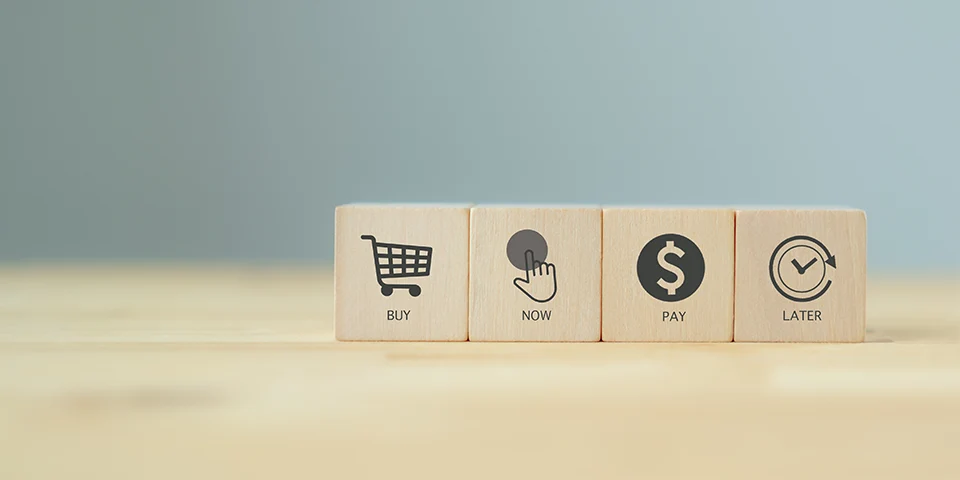More and more people are using Buy Now, Pay Later in e-commerce. While BNPL has been dominated by FinTechs and payment service providers such as Paypal and Klarna for a long time, the flexible payment method is becoming increasingly important for banks. In this article, you will learn how banks can use BNPL to strengthen customer loyalty and how it can be implemented.
How Buy Now, Pay Later works
Buy Now, Pay Later (BNPL) is a payment method that allows consumers to pay for a purchase in instalments over a specified period of time - usually monthly or biweekly. Consumers do not incur any interest as long as payment is made within the specified time period.
The payments are handled by BNPL providers. They define a clear repayment schedule and users know the amount of each payment in advance. They also assume responsibility for outstanding payments. In return, merchants pay fees but benefit from receiving the full amount immediately instead of having to wait for successive instalment payments from customers. This approach optimises the merchant's liquidity and minimises their credit risk at the same time.
The importance and development of BNPL
Buy Now, Pay Later has experienced a significant boom across Europe in recent years, notably accelerated by the COVID-19 pandemic. The rise in e-commerce spending during the pandemic played a crucial role in this expansion. As consumers increasingly turned to online shopping, various online payment providers specialising in purchase on account saw an opportunity to further develop this payment method for online shopping. Originally focussed on beauty and clothing purchases, BNPL has successfully expanded into various sectors, which underlines its increasing popularity.
The BNPL trend remains unabated to this day. Especially in the current economic situation characterised by inflation, high energy prices, and rising interest rates, consumers desire flexibility in payment. Examining the trend in private credit acquisitions illustrates the significance of Buy Now, Pay Later: According to the SCHUFA Risk and Credit Compass 2023¹, small loans under €1,000 experienced a 90% increase from 2021 to 2022. Much of this growth is attributed to the proliferation of BNPL offerings in e-commerce.
For the future, Juniper² forecasts that the BNPL market will reach a volume of $895 billion by 2027. This development is supported by the increasing number of BNPL users worldwide, expected to surpass 900 million by 2027, representing a 157% increase compared to 2022.
BNPL: High popularity among Millennials and Generation Z
The adoption of Buy Now, Pay Later extends across all demographic segments and income levels, as indicated by a study conducted by PYMNTS and Amount³. Millennials and Generation Z, in particular, appreciate the benefits of BNPL. According to this study, over 60% of Millennials are among the consumers who would use a BNPL plan issued by a bank. Among Generation Z, 54% expressed interest in using BNPL.
What makes BNPL particularly appealing is the financial flexibility it provides. Consumers only need to make payments once they have received the entire product and are satisfied with it, offering protection against unscrupulous providers. Additionally, the amount to be paid is adjusted in the case of returns, eliminating the need for consumers to pay in advance. This desire for security is particularly pronounced, especially with expensive products or fashion items, where consumers often expect returns.
Pros and cons of Buy Now, Pay Later for merchants, customers and banks
The integration of BNPL into payment transactions has a significant impact on both merchants and customers.
The leading BNPL providers in Europe
Among the prominent providers in Europe, some of which operate as standalone brands, are:
The mentioned providers are primarily B2C service providers. To date, BNPL companies are underrepresented in the B2B sector.
The entry of banks into the BNPL market
As Credi2’s ⁴ Embedded Finance Study 2022 shows, banks are increasingly positioning themselves in the BNPL market. The upcoming revision of the EU Consumer Credit Directive, which regulates microloans and BNPL products more strictly, offers banks a favourable opportunity to become active. It obliges lenders to conduct a creditworthiness check even for microloans of less than €200. This requirement now also applies to BNPL products and interest-free loans with a maximum term of three months - previously unregulated financial instruments. EU member states must transpose the directive into national law by 2026.
The new regulation entails high regulatory requirements. Banks already have experience in fulfilling these requirements, giving them an advantage compared to FinTech companies. The new regulation not only protects banks from potential risks, but also offers consumers protection against over-indebtedness.
Why do consumers prefer traditional banks to FinTechs?
As established brands, banks enjoy a high reputation and trust among consumers. According to the Global Consumer Payments Survey 2022 by the Accenture Banking Blog⁵, four out of ten users prefer BNPL offerings from their bank. 84% of consumers trust their bank as a secure authority for payments, while only 31% trust BNPL providers.The study by PYMNTS and Amount³ confirms the trend.
For banks, the implementation of BNPL solutions is essential, as not doing so could lead to a significant loss of revenue. The study by PYMNTS and Amount shows that banks that hesitate to invest in BNPL could lose up to 89 billion dollars in revenue by 2025.
BNPL: opportunity or threat for banks?
At a time when consumers are increasingly looking for financial flexibility, BNPL solutions are therefore not only a competitive advantage, but also a strategic necessity for banks to strengthen their trust capital and promote future growth.
While there are many benefits to banks implementing BNPL services, there are also certain challenges to overcome. One significant aspect is the considerable effort required to provide the necessary infrastructure. For banks that operate in the retail sector and have existing relationships with retailers, integrating BNPL may be easier if they already have an existing structure and the necessary technology in place.
Ultimately, each bank will need to carefully consider the benefits and costs of entering the BNPL market and make a decision based on their individual circumstances.
How can banks implement Buy Now, Pay Later?
Banks have various options for integrating BNPL into their offerings. One option is to enter into external partnerships with established BNPL providers. According to the Embedded Finance Study 2022 by Credi2⁴, 80% of German banks already rely on external partners in order to bring a solution to market quickly while minimising their own risk.
Alternatively, there is the option of an in-house solution in which banks create a BNPL offering via their own digital channels and customer contact points, for example by expanding mobile/web banking or wallet apps. Within the app, banks can give their customers the option to pay in instalments after making a purchase.
Open banking can make an important contribution to effective risk management and high-quality credit scoring. By accessing Open Banking data, banks can offer their customers precise and up-to-date evaluations of their creditworthiness instantly. A comprehensive analysis of customers' financial situations and habits leads to higher approval rates and enables the ideal customisation of BNPL offers to individual needs. Netcetera participates as a partner in the OpenBankingProject.ch to promote the development of innovative and efficient solutions.
Precise risk assessment, reliable credit scoring and seamless integration into the existing banking infrastructure and banking apps are essential to maximise the potential of BNPL. Netcetera offers comprehensive solutions that can meet these requirements. Our modular and open digital banking solution can be adapted to the individual needs of customers and, thanks to its modular structure, offers standardised integration to core banking systems and third-party solutions. With our technologies, banks are not only able to meet the current requirements of the BNPL market, but are also equipped for future developments.
1 SCHUFA Risiko- und Kredit-Kompass 2023
2 Pay later trends 2023 - What's to come?
3 60% of Millennials Are Interested in BNPL Plans From Their Banks
5 Payments gets personal How to remain relevant as consumers seek control
At Netcetera, we offer a range of customizable features and services that can be easily integrated into existing web and mobile banking solutions. To learn more about how we could help your bank, speak with our experts.
More stories
On this topic


